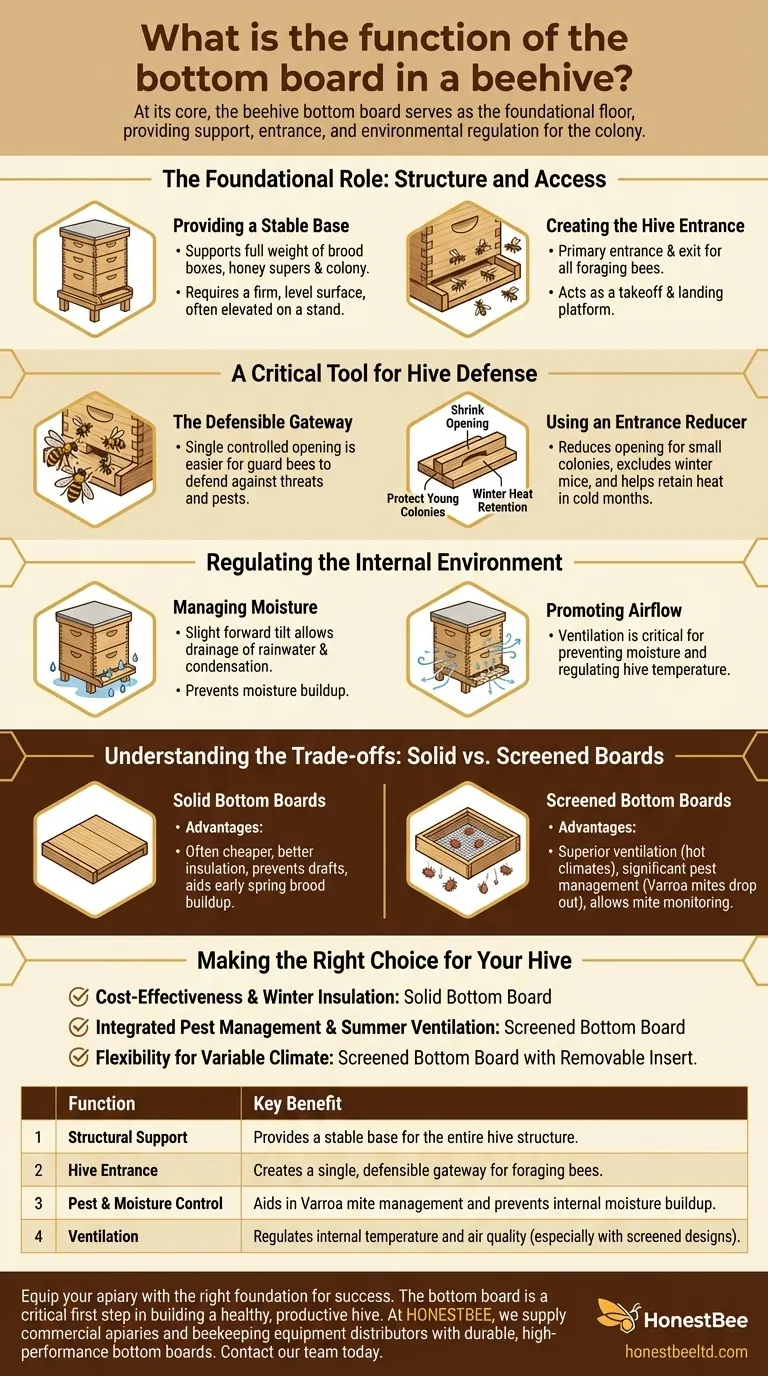At its core, the beehive bottom board serves as the foundational floor of the hive. It provides structural support for the entire colony, creates a single, defensible entrance for the bees, and plays a crucial role in regulating the hive's internal environment, from ventilation to pest control.
The bottom board is not merely a passive floor; it is the hive's primary interface with the outside world. Your choice between a solid or screened design is a fundamental decision that directly impacts hive ventilation, moisture control, and your strategy for managing pests like Varroa mites.

The Foundational Role: Structure and Access
Providing a Stable Base
The bottom board supports the full weight of the brood boxes, honey supers, and the colony itself. It is the literal foundation of the entire structure.
For this reason, it must be placed on a firm, level surface. Using a hive stand to raise it off the ground is standard practice to prevent wood rot and ensure long-term stability.
Creating the Hive Entrance
When the first hive body is placed on top, the bottom board's design creates a dedicated opening at the front.
This opening serves as the colony's primary entrance and exit, acting as a takeoff and landing platform for all foraging bees.
A Critical Tool for Hive Defense
The Defensible Gateway
A single, controlled entrance is far easier for guard bees to defend against threats. It funnels potential intruders, such as robbing bees from other hives or pests, into a manageable chokepoint.
Using an Entrance Reducer
An entrance reducer is a small block of wood used to shrink the size of this opening. This is critical for young or small colonies whose populations are not yet large enough to defend a full-sized entrance.
Reducers also protect the hive from mice in the winter and can be adjusted to provide a smaller opening during cold months to help the bees retain heat.
Regulating the Internal Environment
Managing Moisture
Proper moisture control is essential for a healthy colony. The bottom board should be tilted slightly forward, allowing any rainwater that enters or condensation that forms inside to drain out.
Keeping the entire hive elevated off the damp ground is another key function of a properly installed bottom board and stand.
Promoting Airflow
Ventilation is critical for preventing moisture buildup and helping the bees regulate the hive's temperature. This is where the type of bottom board you choose becomes most important.
Understanding the Trade-offs: Solid vs. Screened Boards
The two primary types of bottom boards offer distinct advantages and are suited for different management philosophies and climates.
The Case for Solid Bottom Boards
A traditional solid wood bottom board is often cheaper to build or purchase.
By providing better insulation and preventing drafts from below, it may help the colony build up its brood population more quickly in the early spring.
The Advantage of Screened Bottom Boards
A screened bottom board replaces the solid wood floor with a durable wire mesh. This design offers superior ventilation, which is highly beneficial in hot climates.
Its most significant benefit is in pest management. As Varroa mites fall off bees, many will drop through the screen and out of the hive, unable to climb back up to re-infest the colony. It also allows beekeepers to easily monitor mite levels by placing a sticky board underneath for a short period.
Making the Right Choice for Your Hive
Selecting the correct bottom board is a strategic decision based on your local climate and pest management goals.
- If your primary focus is cost-effectiveness and maximum winter insulation: A solid bottom board is a reliable and traditional choice.
- If your primary focus is integrated pest management and superior summer ventilation: A screened bottom board offers significant advantages for monitoring and controlling Varroa mites.
- If you seek the most flexibility for a variable climate: A screened bottom board with a removable insert or slide-in panel provides the benefits of both designs.
Ultimately, viewing the bottom board as a strategic tool empowers you to better manage your colony's health, defense, and productivity.
Summary Table:
| Function | Key Benefit |
|---|---|
| Structural Support | Provides a stable base for the entire hive structure. |
| Hive Entrance | Creates a single, defensible gateway for foraging bees. |
| Pest & Moisture Control | Aids in Varroa mite management and prevents internal moisture buildup. |
| Ventilation | Regulates internal temperature and air quality (especially with screened designs). |
Equip your apiary with the right foundation for success. The bottom board is a critical first step in building a healthy, productive hive. At HONESTBEE, we supply commercial apiaries and beekeeping equipment distributors with durable, high-performance bottom boards—both solid and screened—designed for optimal hive management. Let our wholesale-focused expertise help you build a stronger operation. Contact our team today to discuss your equipment needs.
Visual Guide

Related Products
- Langstroth Solid Bottom Board for Beekeeping
- Langstroth Screen Bottom Board for Beekeeping Wholesale
- Australian Pine Wood Langstroth Screen Bottom Board for Wholesale
- Professional Drop-Style Hive Handles for Beekeeping
- Professional Engraved Round Hive Number Tags for Beekeeping
People Also Ask
- What is the suggested approach for choosing hive boards if you have only 1 or 2 hives? Test Both Types to Find Your Perfect Fit.
- What are the characteristics of a solid bottom board? A Guide to Hive Foundation & Climate Control
- What is the purpose of a solid bottom board in a hive? Essential for Winter Survival & Insulation
- How is the solid bottom board constructed to ensure durability? Built for Longevity with Quality Wood & Beeswax
- What factors should be considered when choosing between a solid and screened bottom board? Make the Right Choice for Your Hive's Health



















